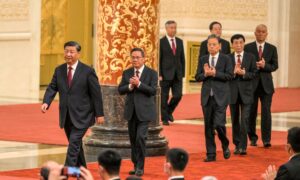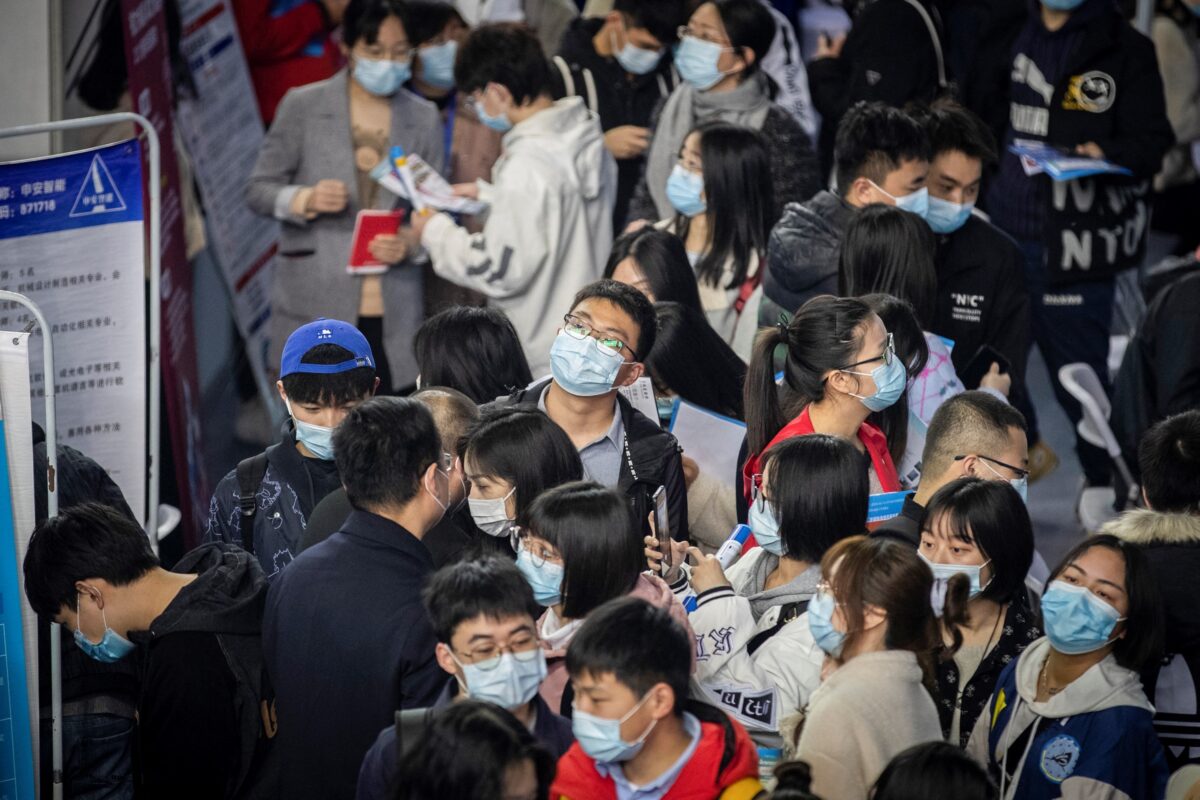Xi Jinping: With Unlimited Power Comes Unlimited Challenge
Commentary Xi Jinping has amassed a greater concentration of power than Mao Zedong, and has greater power to suppress domestic and foreign opponents than any Chinese leader in history. And yet the threat to his—and the Chinese Communist Party’s (CCP)—ability to retain power faces challenges of an enormity and imminence that Mao never knew. These threats, ironically, parallel the disruptive elements that ensured the collapse of Imperial Chinese Qing Dynasty power in 1911–12, ending more than 2,100 years of imperial governance of China. Not that the subsequent republican governments were not imperial—that is, governing an empire of component or tributary societies—but they were, and are, supposedly non-dynastic. Firstly, the isolation of the Manchu rulers of the Qing court paralleled the growing separation today of the CCP from mainland Chinese society. Secondly, modern, often foreign, technology had, from the 18th century, made urbanization appealing to the rural Chinese people and induced a sense of individual aspiration, which could not be fulfilled by the government, translating hope into anger and a sense of entitlement. It was a time of major population disruption and movement. This paralleled the situation in 21st-century mainland China. The Qing court, Mao, and Xi all attempted to suppress the foreign influences that ostensibly triggered the unrest. China, in 1918, saw less than 8 percent of its 395 million population urbanized; China in 2022 had 64.7 percent of its 1.3 billion people urbanized. China has historically seen fluctuations in population levels and movement, some better managed than others. But unmanaged urban unrest—particularly from migrant workers in the cities—was a key factor in the 1908–1912 revolutionary period. Today, Xi and the CCP have unparalleled population control technologies and forces, including the use of indirect means of population control (such as “zero COVID” health mandates). And yet the scale of popular unrest has begun to show evidence that it is overwhelming even the multi-faceted technologies designed to identify anti-CCP elements and deprive them of their access to communications, money, food, and shelter. University graduates attend a career fair in Wuhan, in central China’s Hubei Province, on March 21, 2021. (STR/AFP/Getty Images) Of particular concern to the CCP is the youth unemployment rate among university graduates, where anger levels are highest. The official youth (16- to 24-year-old) urban unemployment rate was 19.6 percent as of March, but the real rate is believed to be much higher. What is so dramatic about the current situation is that the dream of prosperity based on a university degree has now effectively evaporated, compounding the sense of alienation. Coupled with this is the abrupt loss of savings and opportunities also felt by middle-aged and older Chinese with the collapse of the domestic housing economy, which had been the major (often only) place to store savings for retirement. On top of this, agricultural output is, in real terms, declining, and the global market for Chinese-produced manufactures is declining at a rate not fully shown in official statistics. So employment opportunities for all levels of society are disappearing. The hoped-for “post-COVID bump”—the economic recovery after the end of COVID measures—in the first half of 2023 was a significant disappointment to the public and CCP alike. Xi’s attempt to build population control measures cannot match the rising unrest, even though domestic security budgets exceed the Chinese military’s funding for “national defense.” Diverting blame for the national angst through measures like the artificial “zero COVID” health care population suppression has failed to stem the tide. Xi’s attempts to show success on the world stage have also been significant but have not offset the domestic problems. In short, all the positive gains—including the rising potential of the yuan as a global trading currency and China’s ability to acquire energy and food from Russia as a result of the West’s sanctions against Moscow—do not yet compensate for the growing domestic economic situation, although they may have slowed the rate of decline. There has been concern that Xi might, as a distracting measure, attempt to replace food on the Chinese tables by fulfilling his promise to end the Chinese Civil War and destroy the Republic of China (ROC, Taiwan’s official name): Fill the heart if not the belly. The threat from external powers to China’s security, or the United States’ ability to deny markets to China, for example, are actually useful—insofar as they exist at all—in creating a unifying sense of identity among the mainland Chinese people. But at this stage, “defeating” the United States and the West may be far from Xi’s mind, even though he could not say it. He has more important concerns. But the threat from the West is disappearing because of its own decline. What will the post-China and

Commentary
Xi Jinping has amassed a greater concentration of power than Mao Zedong, and has greater power to suppress domestic and foreign opponents than any Chinese leader in history. And yet the threat to his—and the Chinese Communist Party’s (CCP)—ability to retain power faces challenges of an enormity and imminence that Mao never knew.
These threats, ironically, parallel the disruptive elements that ensured the collapse of Imperial Chinese Qing Dynasty power in 1911–12, ending more than 2,100 years of imperial governance of China. Not that the subsequent republican governments were not imperial—that is, governing an empire of component or tributary societies—but they were, and are, supposedly non-dynastic.
Firstly, the isolation of the Manchu rulers of the Qing court paralleled the growing separation today of the CCP from mainland Chinese society.
Secondly, modern, often foreign, technology had, from the 18th century, made urbanization appealing to the rural Chinese people and induced a sense of individual aspiration, which could not be fulfilled by the government, translating hope into anger and a sense of entitlement. It was a time of major population disruption and movement. This paralleled the situation in 21st-century mainland China. The Qing court, Mao, and Xi all attempted to suppress the foreign influences that ostensibly triggered the unrest.
China, in 1918, saw less than 8 percent of its 395 million population urbanized; China in 2022 had 64.7 percent of its 1.3 billion people urbanized. China has historically seen fluctuations in population levels and movement, some better managed than others. But unmanaged urban unrest—particularly from migrant workers in the cities—was a key factor in the 1908–1912 revolutionary period.
Today, Xi and the CCP have unparalleled population control technologies and forces, including the use of indirect means of population control (such as “zero COVID” health mandates). And yet the scale of popular unrest has begun to show evidence that it is overwhelming even the multi-faceted technologies designed to identify anti-CCP elements and deprive them of their access to communications, money, food, and shelter.

Of particular concern to the CCP is the youth unemployment rate among university graduates, where anger levels are highest. The official youth (16- to 24-year-old) urban unemployment rate was 19.6 percent as of March, but the real rate is believed to be much higher. What is so dramatic about the current situation is that the dream of prosperity based on a university degree has now effectively evaporated, compounding the sense of alienation.
Coupled with this is the abrupt loss of savings and opportunities also felt by middle-aged and older Chinese with the collapse of the domestic housing economy, which had been the major (often only) place to store savings for retirement.
On top of this, agricultural output is, in real terms, declining, and the global market for Chinese-produced manufactures is declining at a rate not fully shown in official statistics. So employment opportunities for all levels of society are disappearing. The hoped-for “post-COVID bump”—the economic recovery after the end of COVID measures—in the first half of 2023 was a significant disappointment to the public and CCP alike.
Xi’s attempt to build population control measures cannot match the rising unrest, even though domestic security budgets exceed the Chinese military’s funding for “national defense.” Diverting blame for the national angst through measures like the artificial “zero COVID” health care population suppression has failed to stem the tide. Xi’s attempts to show success on the world stage have also been significant but have not offset the domestic problems.
In short, all the positive gains—including the rising potential of the yuan as a global trading currency and China’s ability to acquire energy and food from Russia as a result of the West’s sanctions against Moscow—do not yet compensate for the growing domestic economic situation, although they may have slowed the rate of decline.
There has been concern that Xi might, as a distracting measure, attempt to replace food on the Chinese tables by fulfilling his promise to end the Chinese Civil War and destroy the Republic of China (ROC, Taiwan’s official name): Fill the heart if not the belly.
The threat from external powers to China’s security, or the United States’ ability to deny markets to China, for example, are actually useful—insofar as they exist at all—in creating a unifying sense of identity among the mainland Chinese people. But at this stage, “defeating” the United States and the West may be far from Xi’s mind, even though he could not say it.
He has more important concerns.
But the threat from the West is disappearing because of its own decline. What will the post-China and post-Western world look like? And when will we see it? Perhaps we are beginning to see it right now.
Views expressed in this article are the opinions of the author and do not necessarily reflect the views of The Epoch Times.












